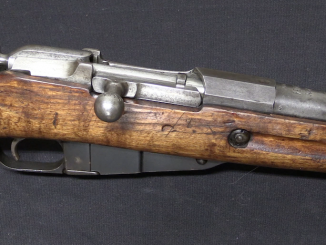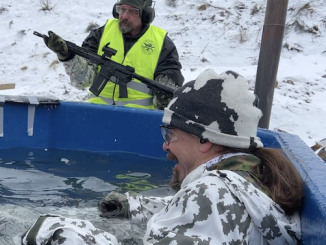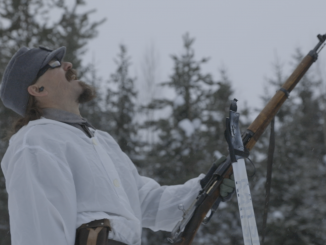The KvKK 62 was a squad automatic counterpart to the Rk 62, Finland’s domestic Kalashnikov rifle. It is an open bolt light machine gun chambered for 7.62x39mm, feeding from push-through RPD-style belts and firing at a rate of about 1000 rounds/minute. Mechanically, the design borrows a lot from the Czech ZB-26 and Bren, with a vertically traveling locking block and long stroke gas piston. Along with that mechanism, it also takes a cue from the Czech 52/57 family of machine guns, in that the pistol grip assembly slides back and forth to function as the bolt handle.
It is also without a doubt the ugliest light machine gun ever fielded by a military force. The weapon elicited a pretty awful reaction whenever I mentioned it to Finns who had used them during military service, but I think this cannot be entirely blamed on the design. When the weapon is clean and in good order, it is not bad to shoot. The high rate of fire is remarkably controllable, and the recoil is not bad (contrary to some reports I have heard).
The two sources of problems are the age of the guns, and the possibility of causing malfunctions through improper handling. During the shooting session where I filmed this, I managed to cause a malfunction that required field stripping the weapon to clear, by loading a belt while the bolt was forward and then attempting to open the bolt to fire. While this was a problem because I goofed the manual of arms, a properly designed military weapon will not allow the user to create this sort of malfunction.
The age of the KvKKs in inventory also contributes to their poor reputation, much like the M60 in US service. As the guns were used by year after year after year of soldiers doing their year of mandatory service, they because worn and unreliable. Combine this with a gun that can be easily jammed up through poor handling, and you have a recipe for a disliked weapon.
In current active-duty Finnish military use, the KvKK 62 has been replaced by the PKM, which is an excellent choice.
Special thanks to Varusteleka (the world’s coolest surplus shop) for arranging access to this weapon!




The Finns replaced a LMG/SAW with a GPMG?
Yes. They bought that iron cheap from the former East Germany, and the PKM is a great MG by any measures.
Shoots the oldest active military round in use, the Russian 7,62x54R which is powerful enough.
I am pretty sure most of the PKMs were purchased directly from Russia in the late 1990s and early 2000s. They were part of the Russian dept payments for Finland. Some were received from former East German stocks with the AFVs purchased in early 1990s, but those remained in experimental use and were not officially adopted for general infantry use. In 2013 some more guns and spare parts were purchased from Russia, this time with hard currency. So, I was wrong about the last purchase date in my earlier post. You can find this info here (in Finnish, sorry):
https://maanpuolustus.net/threads/puolustusvoimat-hankkii-konekiväärejä-venäjältä.2216/
Official info should be possible to find as well, but would require more digging. In any case, official Finnish pages of the Finnish Army say that the PKMs were manufactured in Russia, which in Finnish means explicitly Russian Federation and not Soviet Union. Some of the older ones with laminated wood stocks might still be from old Soviet stocks, no doubt, but received directly from Russia. Most of the ones in use today in Finland have black polymer stocks, which means that they were definitely made after the dissolution of Soviet Union.
Yes and no. PKM is used strictly in the LMG role with a bipod. In fact tripods were not even purchased for them. The Army considers tripod-mounted machine guns of limited usefulness in the prevailing Finnish terrain, and of course budget constraints did not allow for any “extra” hardware that was not considered essential.
“PKM is used strictly in the LMG role with a bipod.”
This is similarity to Russian Pecheneg machine gun:
http://modernfirearms.net/machine/rus/pecheneg-e.html
which technically can be mated with tripod, but bi-pod is considered to be default method of firing
Pecheneg is an excellent gun, but it came only quite recently, so Finns could not buy license for it at time when they were making decision.
I don’t know exactly what you meant, but the Finnish Army or any Finnish company does not have a manufacturing license for the PKM, either. They are all made in Russia (except some early ones in the USSR) and purchased from there, with a good number of spare parts, of course. There are in fact no military small arms factories left in Finland. Sako makes sporting rifles only.
Oh yeah, I forgot that they lost their own production capacity in 1999, as you mentioned before. My wrong.
You also answered my potential question what Sako/ Beretta is up to. The new model of Tikka t3x rifle is phenomenal btw.; my future acquisition.
Yes, cause they are smart. PKM is 7.5kg empty, Minimi is 6.8kg empty. Even with heavier ammo, PKM is a clear winner due the additional range and barrier penetration advantage of 7.62×54 over 5.56.
Well, that and some other practical concerns:
1. The factory which had manufactured the KvKK 62 was closed down for good in 1999, which ended the possibility of making more of them or even just making more spare parts for them.
2. After some testing the late 1980s the Army had decided to keep 7.62×39mm as the only assault rifle caliber for the foreseeable future, but there were no modern LMG designs available off-the-shelf in that caliber.
3. Russia still had debt to Finland from the Soviet era clearing trade and among the few good Russian made goods in the 1990s were weapons. So, the initial two(?) batches of PKMs were in a sense free for the Finnish Army.
“PKM is 7.5kg empty, Minimi is 6.8kg empty.”
Recently, in Russia weapon similar to Minimi was designed, namely Токарь-2
http://vpk-news.ru/news/37065
it is 5,45-mm machine gun, which can be feed from magazine or belt, it is answer to request for 5,45-mm hand-held assault machine gun with combined feed which is supposed to be used in urban environment and enclosed spaces. It can be feed from belt or RPK-74 magazine or AK-74 magazine.
Though first attempts of making 5,45-mm dual feed machine gun were done much earlier – see ПУ-21: https://ru.wikipedia.org/wiki/ПУ-21
created in early 1970s, after some effort it was working as intended, finally to abandon due to fail to make Rakov’s gadget* for 5,45-mm cartridge.
* – device allowing putting cartridges into belt, without it cartridges must be loaded manually, which was seen unacceptable for field service
Rakov’s gadget in action:
https://www.youtube.com/watch?v=q1nbIXaBrLM
Notice that no matter in which direction cartridge lay in hopper of Rakov’s gadget it will be correctly push into belt.
For other loading devices, you might look at photos here:
http://smolbattle.ru/threads/Зарядные-машинки-и-ускорители-заряжания.32101/
KvKK is an acronym for “Kevyt KoneKivääri”, which means “light machine gun” (literally: light machine rifle). Only 6,500 was manufactured, all in the 1960s.
KvKK 62 was never the only light machine gun or squad automatic weapon used by the Finnish Army. It was used concurrently with captured WW2 DP-27 LMGs all the way to the early 2000s, when PKMs were purchased from Russia. The KvKK 62 then became second line weapon replacing the DP-27s, which were scrapped (save for a few for museums and private licensed collectors).
Some units have continued to use the KvKK 62 in training until very recently, because there are no immediate plans to replace them completely in the wartime TO&E. Current political climate strongly disfavors buying weapons from Russia, which effectively prevents further purchases of the PKM (in fact the PKMs were the last ones over 10 years ago and only spare parts have been bought since). The Finnish Army typically keeps weapons around for at least 10-15 years after the last conscripts have been trained in their use. Similarly, some conscripts were still trained with the DP-27 in the late 1980s.
That thing is a pain to handle, but a breeze to fire. Those who shot that a lot told that you could really hit your target 300-600m away.
Well, poor country’s own lMG. Works well enough with same ammo as rifle in use.
“It is also without a doubt the ugliest light machine gun ever fielded by a military force.”
Arguable, as it is subjective matter.
For me more ugly is Kg m/40 (2nd photo from top):
http://modernfirearms.net/machine/swed/knorr-bremse-m40-e.html
bi-pod and carrying handle seems to be glued to ready design, connection between barrel and gas tube looks peculiar and for some reason it is dual rather than single (though not clearly seen on this photo)
Weird dual connection can be seen here:
http://www.gotavapen.se/gota/artiklar/kg/swedish_kg4.htm
on photos described Top – trial model LMG Fm/1940 which became Bottom – the accepted LMG Kg/1940. and Front sight (like Kg m/37)and gas tubes
Thank you for that link Daweo. Absolutely fascinating! I would love to see Iain do a programme on the Swedish Kg m/1940 (SAV), a truly forgotten weapon, and seemingly for very good reasons.
Is there a significant upside to using the grip as a cocking handle? Seems like it makes the ergonomics more difficult, not that these seem great to begin with. Since you didn’t load it until after you cock it, there’s less chance of slamfires? Or am I wrong?
Well, lets think about it: machinegun has heavier action and spring than rifle does. Already at some rifles you can feel pinch pulling on small stubby charging handle. With this hefty grip you can do it lot better. Also, if your firing hand does all this heavy work, your left is free to serve the feed.
When coms to potential of slam-fire that should be excluded by functions interlock. On vz.59 it worked quite well; never seen unintentional fire.
Also notice, that as it is for Finnish forces, usage in snow/winter must be seriously taken into account. Such solution, as found in KvKK 62 seems to be more “gloves-friendly”.
About the high rate of fire: it is a feature that is often criticized, especially because the KvKK 62 lacks a quick change barrel. The shooter has to be fairly cautious not to overheat the barrel. It was a quite deliberate feature, though, and came from WW2 testing of the MG 42, which received overwhelmingly positive feedback from field, and was almost adopted as the new GPMG of the Finnish Army in 1944.
The small arms firepower of the German infantry was also noticed by Finnish soldiers on the receiving side during the so called Lapland War. Even veterans of the Continuation War were impressed and described the German fire as an almost continuous wall of lead.
From what I can see, this is well designed machine gun – purposeful and that is most important. I like some details, specifically, that they used only parts to be machined which relate to locking. Also, connections in sheet metal are made thru oversized rivets instead of complicated welding. Charging is also good element, as mentioned similar to vz.52 and vz59. Oh yes and short and simple feed cover instead of what we see on FN guns. Overall – good work Finns.
I applaud them for not getting sucked into Minimi. They saved themselves of lots of frustration.
… only parts related to locking…”. I know there is more of them, concretely in trigger area. But this is the way to handle long receiver; instead on machining or machining and riveting – stamped heavy gauge sheet.
Interesting the design changes the Finns decided to make on their LMG compared to the original parent weapon, the Czech VZ 52/57 LMG.
I’m sure that Weaponsman.com (Kevin O’Brien, RIP) would have had some fascinating things to add to this story had he lived to see it.
Part of mentioned charging (and some similarity in locking, maybe with vz.26) I do not see direct derivation between vz.52/57/59 and this.
Finnish sources usually mention the vz.52/57 as the main inspiration for the KvKK 62, but significant changes were made during development for various reasons. Why the QCB was dropped is a bit of a mystery, but the explanation I have heard was that carrying an extra barrel was considered unnecessary weight for a weapon which was not really intended for sustained fire.
For comparison, you can watch firing of vz.59 UMG in light version – not that far apart from KvKK62 with exception of caliber, this being full 7.62x54R.
https://www.youtube.com/watch?v=VNE860_gL9Q
Oh yes, and this gun’s belt was also push-thru and non-disintegrating. Very similar concept.
I don’t know about the “ugly” part. It definitely is a big bunch of steel, it doesn’t look like anything unnecessary was added.
The only thing ugly about it is there are none to be bought!!! I like it, very utilitarian. Everything you need, and nothing you don’t.
Where did you get that hat from? And the boots? And jacket?
Also, who cares what a gun looks like? As long as it does its job and is reliable, looks don’t matter.
Hmmm… This is functionally better than a St. Etienne 1907, which was so freakishly complicated that one must ask WHY OVERPAID AND UNDER-EDUCATED NITWITS WERE EVER PERMITTED TO DESIGN WEAPONS FOR USE BY ANY SANE ARMY.
“WHY”
https://en.wikipedia.org/wiki/St._Étienne_Mle_1907 states that
While the tests [of Hotchkiss machine gun] were technically convincing, following which Hotchkiss machine-guns were purchased for French alpine and colonial troops, it was decided for political reasons that a machine gun for French line infantry had to originate from state-owned arms manufacturers.
Simply put, it was a combination of empire-building within the French Army ordnance establishment, and a very British-like desire to avoid paying royalties to Hotchkiss for using their patented gas system design.
The St. Etienne design staff were ordered to come up with a gas-piston system “different” from the Hotchkiss, to avoid patent problems. So, they just turned it around and used a rack-and-pinion system to reverse the forward motion of the piston to the rearward motion of the bolt.
IMHO, this is every bit as silly as a “straight-pull” rifle that uses a cam system tacked on one side to operate what is basically a simple Mauser-style turnbolt. (I’m looking at YOU, Schmidt-Rubin!) This doesn’t just violate the KISS (Keep It Simple, Stupid) principle, it completely inverts it to “The More Complex, The Better”. Umm, no, not in a combat weapon.
It was rather like the way the British Army came up with the .476 Enfield revolver in 1877, with the Owen Jones extraction system, to avoid paying Webley for use of their S&W-style top-break simultaneous-ejection system. The Enfield revolvers were of course such a disaster that they were quickly replaced by actual Webleys.
NB; In the French Army back then, when a weapon was issued, then quickly redefined as “best suited to colonial operations” or “ideal for fortress use”, that meant it truly sucked and they were getting rid of it ASAP in a way that wouldn’t adversely affect the career prospects of those responsible for concocting and adopting the darned thing in the first place. Just FYI.
cheers
eon
“.476 Enfield revolver in 1877”
Though it should be noted that, it has advantage over S&W-style ejection as it removed only spent cases (or at least it was supposed to do so), so it should be rather called, so if S&W-style we call simultaneous-ejection then this should be selective-simultaneous-ejection.
Greetings from Turku! I’ve been traveling in Finland, and was elated to see that Karl and Ian had been here too–or for all I know, are still here!
The British Besal prototype had a pistol grip charging handle, as did the Czech VZ52 with belts or top-mounted ZB26 or Bren magazines… Very informative video, as always.
Cherndog, Read about the Great War vintage US Ordnance Department which
1) Rejected the proven Lewis Gun in favor of the Chauchat and then compounded that blunder by ordering more in 30-06
2) Messed up the 3-inch gun M1916 so badly that it became known as the “Crime of 1916” and forced the US to adopt the French Canon de 75 Mle 1897.
3) Screwed up the conversion of the British P14 Rifle to the 30-06 P17 (M1917) so badly that it became a national scandal (Even Scientific American was denouncing the Army, for Pete’s sake) that the Chief of Ordnance, MG Crozier, was sacked
And Crozier probably compares favorably ro Ripley in the US Civil War
BTW, La Legion Etranger was stripped of its Hotchkiss guns to provide them to troops in the trenches and given the Puteaux instead. No wonder Fort Zinderneuf could barely hold out against the Rifs.